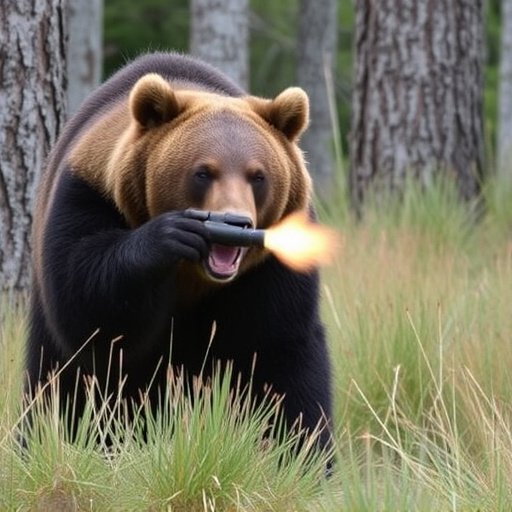Bears, especially grizzlies and black bears, exhibit unpredictable behaviors that necessitate understanding for safe interactions in their habitat. While they usually avoid humans, threats or protective instincts towards cubs can lead to attacks. Bear spray is an effective deterrent, but its use varies regionally due to environmental concerns and local restrictions. It's crucial to be prepared with noise-making, group travel, secure food storage, and knowing appropriate response techniques, as bear spray should not be relied upon as the sole defense. The status of bear spray as a restricted weapon is complex, with laws varying widely; understanding local regulations is essential for its use. In survival scenarios, while bear spray can temporarily incapacitate bears, it has limitations; strategies like noise-making, proper food storage, and following park ranger guidelines enhance survival chances.
In wilderness survival, understanding bear behavior and knowing their attack patterns is key to staying safe. While bear spray has emerged as a popular defense mechanism, its legality and effectiveness vary. This article explores alternative survival techniques and preventive measures, delving into the nuances of bear interactions. We’ll discuss why bear spray, though not universally restricted as a weapon, might not always be the best solution. Learn essential skills to navigate and prevent dangerous encounters in the wild.
- Understanding Bear Behavior and Their Attack Patterns
- Bear Spray: A Legal and Effective Defense Mechanism?
- Alternative Survival Techniques and Preventive Measures
Understanding Bear Behavior and Their Attack Patterns
Bears, especially grizzly bears and black bears, are powerful wild animals with complex behaviors that can be unpredictable at times. Understanding their behavior is crucial for anyone venturing into bear country. Knowing when a bear might consider an encounter as a threat and its subsequent reaction is key to survival. Bears generally avoid humans unless they feel threatened or are protecting their young. Their attack patterns vary; some bears may charge directly, while others will display aggressive posturing, blowing air, or making noise to scare you away.
While carrying weapons for self-defense is a common practice, it’s essential to know that bear spray, when used correctly, can be an effective deterrent. However, not all areas allow the use of bear spray due to environmental concerns and restrictions, so it’s vital to check local regulations. Other protective measures include making noise to avoid surprising bears, traveling in groups, securing food properly, and knowing how to respond if a bear does attack.
Bear Spray: A Legal and Effective Defense Mechanism?
Bear spray has emerged as a popular defense mechanism for wilderness enthusiasts and survivalists facing potential bear attacks. However, an intriguing question arises: is bear spray considered a restricted weapon? The legality and classification of this chemical deterrent vary across regions, which is essential knowledge for anyone venturing into bear country.
In many areas, bear spray is legal and readily available to the public, but its status as a weapon is subject to debate. Some jurisdictions classify it as a defense spray or personal protection device, while others may restrict its use to licensed individuals or law enforcement agencies. This dichotomy in regulations stems from concerns about misuse and potential harm. Yet, proponents argue that bear spray provides an effective and non-lethal means of deterring bears, especially grizzly bears known for their aggressive behavior. Its portability and ease of use make it a popular choice for hikers, campers, and backcountry enthusiasts seeking to protect themselves in bear habitats.
Alternative Survival Techniques and Preventive Measures
In wilderness survival scenarios, when facing potential bear attacks, individuals often look beyond traditional weapons to innovative and alternative survival techniques. While carrying a restricted weapon like bear spray can be an effective deterrent, it’s crucial to understand its limitations and explore additional preventive measures. Bear spray is designed to temporarily incapacitate bears, giving survivors a chance to escape, but its range and effectiveness vary based on factors like wind and the bear’s behavior.
Beyond bear spray, several other strategies can enhance survival chances. This includes making noise during travel to deter bears, avoiding known bear habitats, and properly storing food to minimize attraction. Knowing local bear behaviors and following guidelines from park rangers is paramount. Additionally, carrying alternative self-defense tools like a sturdy stick or a whistle for emergency signaling can provide backup options if bear spray isn’t readily available or effective.
While bear attacks are rare, understanding bear behavior and employing effective protection strategies is crucial for safety in wilderness environments. Bear spray has emerged as a popular defense mechanism, but its legal status and effectiveness vary. Exploring alternative survival techniques, such as noise makers and scent management, offers additional layers of protection. Preventive measures like food storage and awareness training are also vital. Ultimately, staying informed and prepared can significantly reduce the risk of bear encounters turning hazardous. Remember, knowledge is your best defense in the wild.
